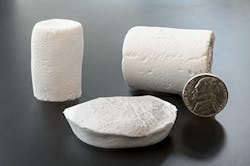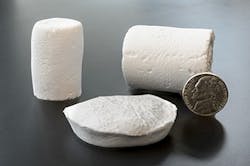Adsorbent Promises Easier Biomanufacturing
Biomanufacturing processes can be complex, costly, and generate yields often too low to make a product commercially viable. To combat this, researchers from the U.S. Department of Energy’s Argonne National Laboratory, Lemont, Ill., developed a highly selective adsorbent to tackle inefficiencies in bioproduct extraction. The material — a xerogel — promises to significantly increase yields while reducing costs and energy consumption for a wide range of products, they believe.
Dubbed EZ Select, the highly porous, high-surface-area nanostructured material can adsorb up to eight times its mass, boasts selectivity approaching 100%, and be reused tens of times, say the researchers. It also can be sized to meet the adsorption needs of specific product quantities.
“EZ Select is a very efficient way of separating the product from a very complex environment, because the only thing that adsorbs onto its surface is the product we’re interested in making,” explains Phil Laible, biophysicist in Argonne’s Biosciences division and a principal investigator on the project.
“You can fill it up with product and then, with just a simple compression, remove the product from the material, which then goes right back into the process to be reused.” he adds.
Figure 1. A xerogel nanomaterial called EZ Select adsorbs desired product from a complex environment. Source: Wes Agresta, Argonne National Laboratory.
The xerogel can be altered or “tuned” to work with different chemistries. The pore sizes of the material can be modified using micelles, or lipids. The researchers can fine-tune it even further using additives for nearly complete control of porosity.
“Our ability to tune it means that we can change chemical functional groups on the surface to attract a particular kind of molecule and exclude others, notes Ed Barry, an applications scientist in Argonne’s Applied Materials division.
EZ Select has a neutral effect on the organisms charged with creating the final product. In some bioproduction schemes, over-concentration of the bioproduct can slow or stop the fermentation process, resulting in lower yields.
Disposing of the material itself at the end of its useful service life poses no issues. “The material is silica based, and silicon dioxide can be disposed of in any setting, as it is already one of the most common compounds in earth’s crust and soils,” comments Laible. However, safe disposal also depends on the application, and what the material has been used to adsorb (e.g., toxic contaminants, etc.).
Size restrictions “are limited only by creativity and the dimensions of the reaction vessel and any safety issues associated with the use of large quantities of silane agents. The synthesis is a solution-based process that scales easily for industrial applications with reactions occurring in large sealed vessels, says Laible.
The researchers believe current variants of xerogels are prime for recovery of hydrophobic bioproducts produced by microbial fermentations. “They also can be used to target and remove inhibitors from feedstock and fermentation streams that limit overall titers, rates, and yields of the desired product. This materials approach works especially well at recovering hydrophobic bioproducts from fermentation systems while still at low concentrations — before problematic emulsions develop or before the product itself can prove inhibitory,” notes Laible.
The material also is designed to capture media and process impurities that inhibit microbial conversion. “Feedstock streams that emanate from agricultural wastes frequently harbor inhibitors of fermentation (e.g., lignin components, aldehydes, and leftover pretreatment catalysts) that limit production systems. This materials approach can target these inhibitors and effectively reduce them to levels benign to maximize productivity,” suggests Laible.
Outside of biomanufacturing, other possible applications for the material include water cleanup, personal-protective-equipment air filtration, hazmat containment and remediation and pharmaceutical production.
“Xerogels are ready for scaled application with additional manufacturing development and testing within industrial settings. Current versions of the material can be ready for targeted commercial applications at scale within months,” concludes Laible.
To learn more, contact [email protected].

